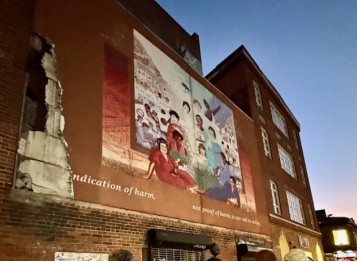
This information below was provided by the Women’s Community Cancer Project (WCCP) for which we are grateful. It outlines the creative process, funding and zoning of the mural on the Harvard Square Theatre.
“In the spring of 1997 Sargent brought her idea to us at the Women’s Community Cancer Project (WCCP) Started in 1989, the WCCP is an all-volunteer, grassroots group focused on stopping cancer before it starts, not just on diagnosis and treatment. It is dedicated to bringing about changes in the medical, social, and political approaches to cancer especially as they affect women. It is in the forefront of the demand that serious attention be given to the connection between toxins in the environment and increasing cancer rates.
We agreed to work with Sargent on creating a mural portraying women activists whose lives were cut short by the disease. We had little idea what was involved. First we needed to find a wall and obtain permission to use it. We found we had to ask for approval from the Cambridge Zoning Commission, which we received. And of course we needed to find funding.
Then we had to select women to be honored. This gave us the opportunity to learn about many people: the twenty-three women nominated by the over one hundred diverse Boston community organizations that we sent letters to, the twelve women we chose to memorialize, their families, and their friends in the various activist communities.
We had the good fortune to receive funding from the Boston Women’s Fund and the Breast Cancer Fund in San Francisco as well as from many individuals. By June 1998 Loew’s Cineplex had donated the wall next to the Harvard Square Theatre on Church Street in Cambridge, Massachusetts.
Sargent intended to paint each woman as a caretaker of a different aspect of the environment. These twelve would stand in for the hundreds and thousands of activists among the more than 270,000 women who die every year in this country from cancer.
We eventually chose three nationally known activists: Rachel Carson, biologist and author of Silent Spring, Audre Lorde, Black lesbian feminist poet, author of The Cancer Journals and Myra Sadker, advocate for gender equality in education and co-author of Failing at Fairness: How Our Schools Cheat Girls. Then we selected nine local women from a diversity of cultures and different types and areas of activism: María Luisa Alvarez, Agnes Barboza, Cindy Chin, Valerie Hinderlie, Jeanmarie Marshall, Esther Rachel Rome, Susan Shapiro, Jacqueline Shearer, and Thelma Vanderhoop Weissberg.
We talked to people who knew the women, in some cases read what they wrote themselves and what was written about their accomplishments. Sadly, we also read their obituaries. It was deeply moving to learn about their work, their passions, the love they inspired in their friends and family, and the tragic fact of their deaths from cancer. The results are the twelve much too short biographies that follow.
Delays in getting permission to use the wall that was donated for the mural meant that Sargent wasn’t able to put up scaffolding and begin to paint until late summer 1998.
Working from photographs of the women given to us by their families, Sargent sketched and painted the twelve figures in brilliant colors. Around them she drew a sea of political activists fighting the poisoning of homes, communities, and workplaces; and demanding accessible, quality health care.
Painted in soft hues of brown, blue, and white, fired-up women (and some children) can be seen marching, speaking, writing, meeting, signing petitions, and holding a candlelight vigil in remembrance of loved ones killed by cancer. Although the artist and the WCCP prefer not to identify them, each is based on a real person.
As fall approached Sargent surrounded the political activists with ten panels depicting in reds and blacks the sources of industrial toxins contributing to the increasing occurrence of cancer.”